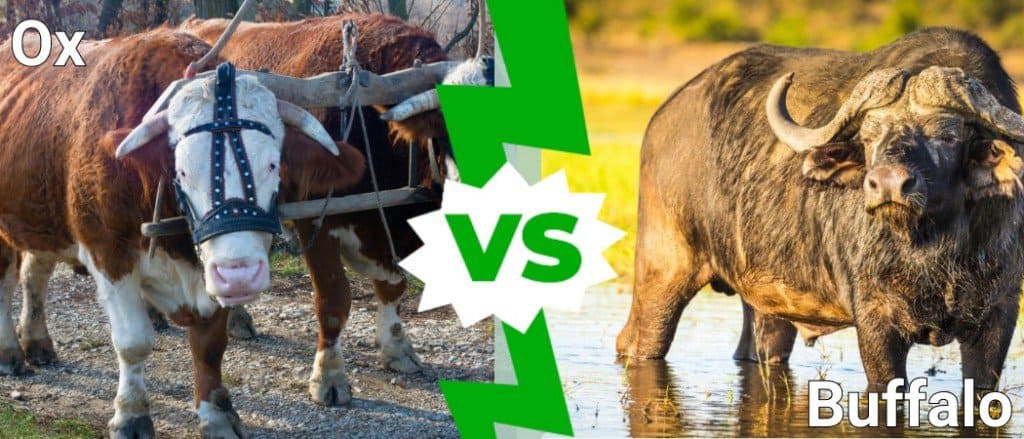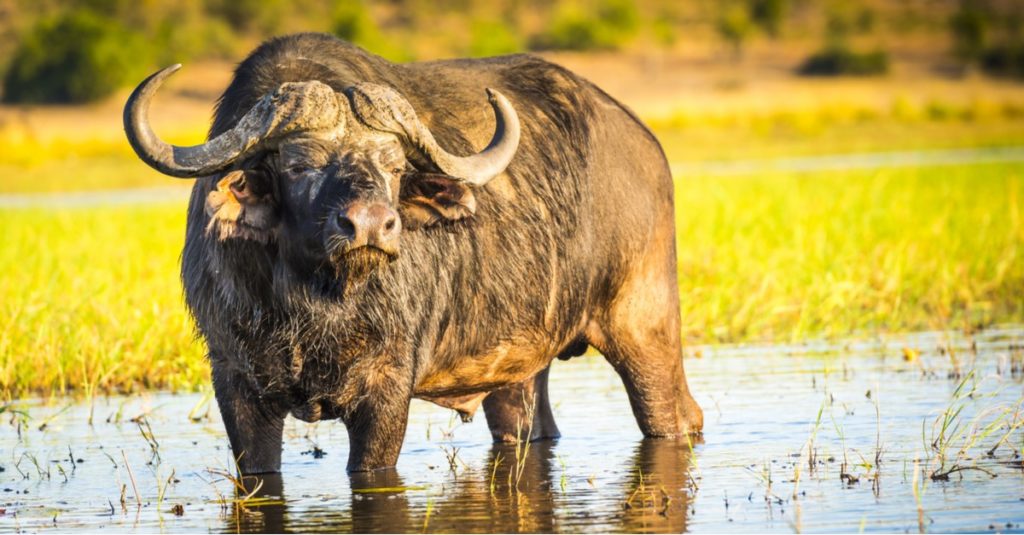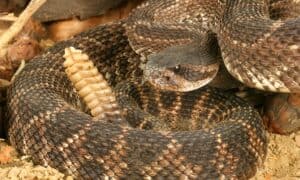Ox Vs Buffalo: What Are the Differences?
The Bovidae family is home to a variety of ruminants, and over a billion of them are alive today. Being that they are all such large creatures and so common, confusing one for another might seem difficult. It’s not, though, and people always ask if steers and bulls are the same things or if bison and oxen are the different species. We’ve helped differentiate between a few of these domesticated and non-domesticated ruminants, and we’re going to continue that trend here. Take a look at the differences between an ox vs buffalo and discover how they’re so different from one another.
Comparing an Ox and a Buffalo

A-Z-Animals.com
| Ox | Buffalo | |
| Size | Weight: 1,500lbs-2,400lbs Height: 50in-68in Length: 92in-103in |
Weight: 1,323lbs-2,000lbs Height: 51in-67in Length: 67in-96in |
| Scientific Name and Family | – Bos taurus Part of the Bovina subtribe | – Syncerus caffer – Part of the Bubalina subtribe, but distinct from Bos |
| Horns | – Grow outward and then straight up | – Horns form a boss, a section where the two horns grow almost together – Horns curl much lower, past their eyes in many cases |
| Colors | Brown, gray, black, white, tan | Dark brown, gray, black |
| Uses | Castrated male cattle that are trained to work for humans after the age of 4 | – African buffalo are not domesticated – Water buffalo, a different species, are domesticated |
| Sex | The term Ox refers specifically to male cattle | – Does not refer to any sex, can have buffalo cows and bulls – Buffalo refers to three species of animals in Africa, one in Asia, and is mistakenly applied American Bison |
The Key Differences Between Ox vs Buffalo

– License
The greatest differences between an ox and buffalo are their size, horns, and species. Oxen are larger than buffalo, have horns that grow slightly outward and curve sharply upward instead of very wide horns, and belong to the Bos genus rather than the Bubalis genus.
These are just a few of the main differences that exist between oxen and buffalo. Many others exist and more details are needed about the concepts introduced already. We shall go into greater detail regarding all of these differences.
Ox vs Buffalo: Size
Oxen are larger than buffalo in a lot of cases. As large male cattle, oxen are bred to be very large and strong, so they can weigh up to 2,400lbs, stand 68 inches high, and grow 100 inches or more long. Buffalo can weigh up to 2,000lbs, stand 67 inches tall, and grow about 96 inches.
Of course, there are some cases where a large buffalo will outweigh and outgrow an ox. These numbers are just helpful guidelines for visualizing the sizes of these vast creatures.
Ox vs Buffalo: Scientific Name
Oxen are named Bos taurus and Buffalo are named Syncerus caffer. The differences in these names somewhat capture how dissimilar they are in terms of their phylogenic families. Oxen belong to the Bovina subtribe of the Bovidae family that groups them with cattle and bison. The Bos genus contains all the cattle that most people think of when we consider dairy cows and steer.
Buffalo are part of the Bubalina subtribe, a tribe of Bovidae but still distinct from Bos. The two genera in Bubalina are Bubalus and Syncerus, the African and Asian bovids, respectively. Within these groups, you will find the African buffalo, the most commonly accepted “buffalo” creature, along with the water buffalo, a popular Asian bovid.
Detangling these names help differentiate these animals.
Ox vs Buffalo: Horns

THP Creative/Shutterstock.com
The horns of an ox are smaller than buffalo horns, and they grow slightly outward but mostly upwards in most cases. However, some cases exist where oxen and buffalo both have very long horns. For example, the Texas Longhorn breed of cattle is known for their massive set of horns that can reach over 8 feet in length from tip to tip. Those horns grow far outward like buffalo, and some of them are oxen.
Buffalo have very different horns than oxen. Their horns are rooted directly next to each other, forming a bone plate that is referred to as a boss. Oxen do not have a boss.
African buffalo have horns that reach about five feet in length from tip to tip, but water buffalo horns can get much longer. In fact, a record-setting rack of water buffalo horns measured about 13 feet and 10 inches!
For the most part, though, buffalo horns are larger than ox horns because most of the Bos oxen have small horns.
Ox vs Buffalo: Colors
Oxen are brown, gray, white, tan, and black for the most part. They can have many different patterns on their hair coat as well. Buffalo mostly have a single-color coat of hair that is usually very dark brown or black, but they can gray as they get older.
If you see a tan or light brown bovine, the chances are that it is not a buffalo of any sort.
Ox vs Buffalo: Uses

iStock.com/tadija
Oxen are specifically used as work animals in the agriculture industry. They are trained from the time they are born until they are four years old to learn how to obey the commands of farmers. After their training is complete, oxen are used to plow fields, pull carts, and more.
The buffalo species that is most commonly identified by that name is the African buffalo, and none of those creatures have been domesticated. They are simply too wild to domesticate. However, water buffalo, not technically the buffalo that we’re talking about, are used just as much as oxen for agriculture.
For the most part, though, buffalo are just wild animals living in Africa.
Ox vs Buffalo: Sex

Oxen are specifically male cattle from the Bos family, but buffalo do not have any specific sex attached to the term. Buffalo can have cows and bulls, females and males. As we’ve said before, buffalo is a name that is often mistakenly applied to multiple species and subspecies, including three different kinds in Africa, on in Asia, and the American Bison.
Oxen and buffalo are very different creatures. Even though they have some things in common since they are members of the same biological family, their size, uses, and habitats set them apart. Now that you’ve read this article, you can tell these animals apart by their horns, size, and locations!
More from A-Z Animals
The Bovidae family is home to a variety of ruminants, and over a billion of them are alive today. Being that they are all such large creatures and so common, confusing one for another might seem difficult. It’s not, though, and people always ask if steers and bulls are the same things or if bison and oxen are the different species. We’ve helped differentiate between a few of these domesticated and non-domesticated ruminants, and we’re going to continue that trend here. Take a look at the differences between an ox vs buffalo and discover how they’re so different from one another.
Comparing an Ox and a Buffalo

A-Z-Animals.com
| Ox | Buffalo | |
| Size | Weight: 1,500lbs-2,400lbs Height: 50in-68in Length: 92in-103in |
Weight: 1,323lbs-2,000lbs Height: 51in-67in Length: 67in-96in |
| Scientific Name and Family | – Bos taurus Part of the Bovina subtribe | – Syncerus caffer – Part of the Bubalina subtribe, but distinct from Bos |
| Horns | – Grow outward and then straight up | – Horns form a boss, a section where the two horns grow almost together – Horns curl much lower, past their eyes in many cases |
| Colors | Brown, gray, black, white, tan | Dark brown, gray, black |
| Uses | Castrated male cattle that are trained to work for humans after the age of 4 | – African buffalo are not domesticated – Water buffalo, a different species, are domesticated |
| Sex | The term Ox refers specifically to male cattle | – Does not refer to any sex, can have buffalo cows and bulls – Buffalo refers to three species of animals in Africa, one in Asia, and is mistakenly applied American Bison |
The Key Differences Between Ox vs Buffalo

– License
The greatest differences between an ox and buffalo are their size, horns, and species. Oxen are larger than buffalo, have horns that grow slightly outward and curve sharply upward instead of very wide horns, and belong to the Bos genus rather than the Bubalis genus.
These are just a few of the main differences that exist between oxen and buffalo. Many others exist and more details are needed about the concepts introduced already. We shall go into greater detail regarding all of these differences.
Ox vs Buffalo: Size
Oxen are larger than buffalo in a lot of cases. As large male cattle, oxen are bred to be very large and strong, so they can weigh up to 2,400lbs, stand 68 inches high, and grow 100 inches or more long. Buffalo can weigh up to 2,000lbs, stand 67 inches tall, and grow about 96 inches.
Of course, there are some cases where a large buffalo will outweigh and outgrow an ox. These numbers are just helpful guidelines for visualizing the sizes of these vast creatures.
Ox vs Buffalo: Scientific Name
Oxen are named Bos taurus and Buffalo are named Syncerus caffer. The differences in these names somewhat capture how dissimilar they are in terms of their phylogenic families. Oxen belong to the Bovina subtribe of the Bovidae family that groups them with cattle and bison. The Bos genus contains all the cattle that most people think of when we consider dairy cows and steer.
Buffalo are part of the Bubalina subtribe, a tribe of Bovidae but still distinct from Bos. The two genera in Bubalina are Bubalus and Syncerus, the African and Asian bovids, respectively. Within these groups, you will find the African buffalo, the most commonly accepted “buffalo” creature, along with the water buffalo, a popular Asian bovid.
Detangling these names help differentiate these animals.
Ox vs Buffalo: Horns

THP Creative/Shutterstock.com
The horns of an ox are smaller than buffalo horns, and they grow slightly outward but mostly upwards in most cases. However, some cases exist where oxen and buffalo both have very long horns. For example, the Texas Longhorn breed of cattle is known for their massive set of horns that can reach over 8 feet in length from tip to tip. Those horns grow far outward like buffalo, and some of them are oxen.
Buffalo have very different horns than oxen. Their horns are rooted directly next to each other, forming a bone plate that is referred to as a boss. Oxen do not have a boss.
African buffalo have horns that reach about five feet in length from tip to tip, but water buffalo horns can get much longer. In fact, a record-setting rack of water buffalo horns measured about 13 feet and 10 inches!
For the most part, though, buffalo horns are larger than ox horns because most of the Bos oxen have small horns.
Ox vs Buffalo: Colors
Oxen are brown, gray, white, tan, and black for the most part. They can have many different patterns on their hair coat as well. Buffalo mostly have a single-color coat of hair that is usually very dark brown or black, but they can gray as they get older.
If you see a tan or light brown bovine, the chances are that it is not a buffalo of any sort.
Ox vs Buffalo: Uses

iStock.com/tadija
Oxen are specifically used as work animals in the agriculture industry. They are trained from the time they are born until they are four years old to learn how to obey the commands of farmers. After their training is complete, oxen are used to plow fields, pull carts, and more.
The buffalo species that is most commonly identified by that name is the African buffalo, and none of those creatures have been domesticated. They are simply too wild to domesticate. However, water buffalo, not technically the buffalo that we’re talking about, are used just as much as oxen for agriculture.
For the most part, though, buffalo are just wild animals living in Africa.
Ox vs Buffalo: Sex

Oxen are specifically male cattle from the Bos family, but buffalo do not have any specific sex attached to the term. Buffalo can have cows and bulls, females and males. As we’ve said before, buffalo is a name that is often mistakenly applied to multiple species and subspecies, including three different kinds in Africa, on in Asia, and the American Bison.
Oxen and buffalo are very different creatures. Even though they have some things in common since they are members of the same biological family, their size, uses, and habitats set them apart. Now that you’ve read this article, you can tell these animals apart by their horns, size, and locations!









